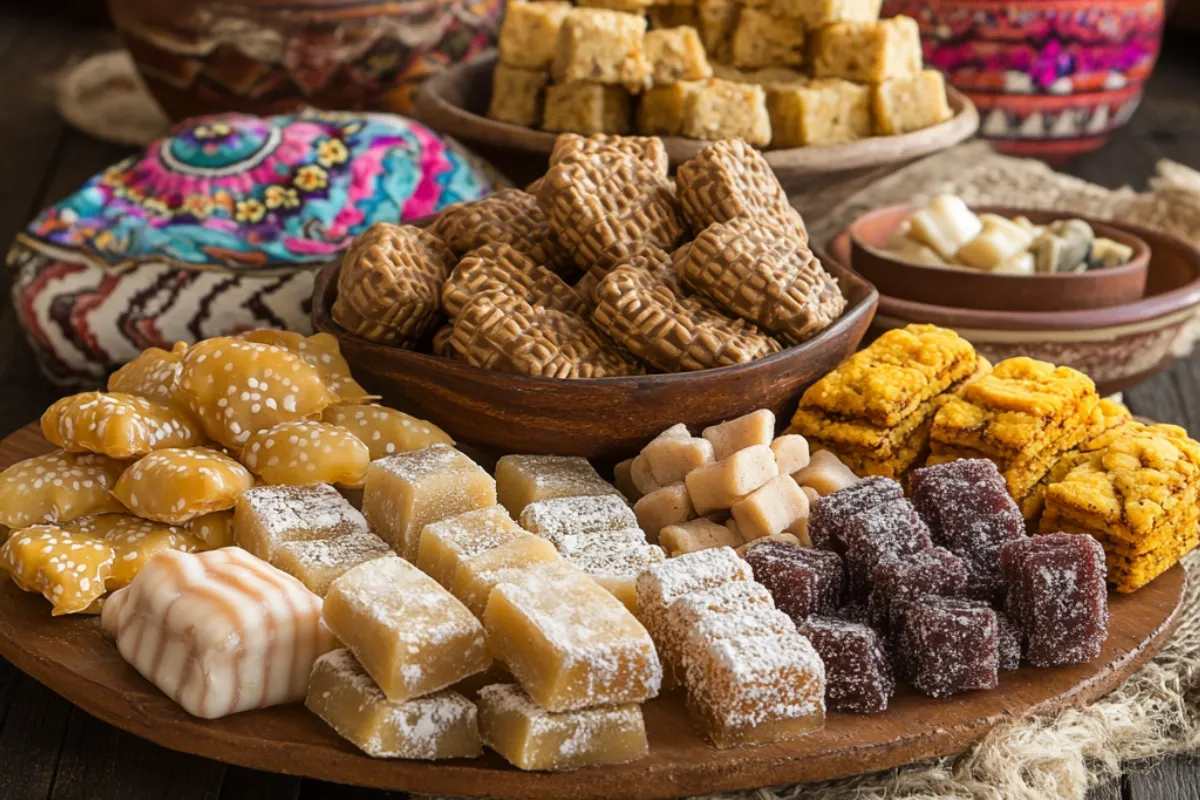Mexico’s rich and diverse culinary tradition is a tapestry of flavors, textures, and history. Among the many delights that Mexican cuisine offers, candies hold a special place. They are not just treats but symbols of cultural heritage, deeply rooted in the country’s history. In this article, we explore the origins of Mexico’s oldest candies, delve into the fascinating stories behind them, and examine their evolution over the centuries.
Historical Background of Mexican Sweets
The history of Mexican sweets dates back to pre-Hispanic times when indigenous people made use of natural ingredients like honey, cacao, and various fruits to create early forms of candy. People often used these early sweets in religious ceremonies or as offerings to the gods. When the Spanish arrived in the 16th century, they introduced new ingredients and techniques, which led to the creation of many traditional candies that people still enjoy today.
- Pre-Hispanic Era: Indigenous people used honey, cacao, and fruits to create sweets.
- Spanish Influence: Introduction of sugar and European confectionery techniques.
- Cultural Fusion: A blend of indigenous and European practices created a unique confectionery tradition.
One of the oldest known candies in Mexico is Cajeta-filled wafers (Obleas con Cajeta). These delicate, wafer-thin disks filled with sweet, caramel-like cajeta have been a part of Mexican culture for centuries. Cajeta, a sweet made from goat’s milk, has roots in the colonial era and has remained a beloved ingredient in Mexican sweets.
The Oldest Candy in Mexico
Identifying the absolute oldest candy in Mexico is challenging due to the country’s vast and varied confectionery history. However, one of the contenders for this title is Mazapán De la Rosa, a peanut-based marzipan that has been a staple of Mexican sweet shops for decades. The origins trace back to the mid-20th century, inspired by the much older Spanish almond marzipan, which dates back several centuries.
Mazapán De la Rosa is a perfect example of how Mexican candies have evolved while still maintaining a connection to their roots. Made primarily from peanuts, sugar, and a touch of flavoring, this sweet treat is not only popular in Mexico but has also gained international fame.
For a deeper understanding of how chili powder enhances the flavor of candies, consider reading Why You Should Be Adding Chili Powder to Your Candy. This article delves into the Mexican tradition of combining sweet and spicy flavors, a hallmark of many traditional candies.
Another key aspect of Mexican sweets is the use of cacao, a product native to Mexico and a significant part of the country’s cultural heritage. To learn more about the history of cacao in Mexican sweets, you can explore The History of Chocolate in Mexico.
Detailed Exploration of Traditional Mexican Candies
Top Traditional Candies in Mexico
Mexican candies are known for their unique flavors, often combining sweet, spicy, sour, and salty tastes. Here are some of the most iconic traditional candies that have been enjoyed for generations:
- Cajeta-filled Wafers (Obleas con Cajeta): Thin wafers filled with cajeta, a sweet made from goat’s milk.
- Glorias de Linares: Dulce de leche-based candies, often covered in pecans, originating from Linares, Nuevo León.
- Pulparindo: A tangy and spicy tamarind candy that is a favorite among those who enjoy a little heat with their sweets.
Each of these candies has a rich history and cultural significance, often tied to specific regions or traditions within Mexico.
Cajeta-filled Wafers (Obleas con Cajeta)
Cajeta-filled wafers, known as Obleas con Cajeta, are a prime example of Mexico’s ability to blend simplicity with flavor. These wafers have a sacred origin, initially brought to Mexico by Spanish missionaries who used them as consecrated wafers. Over time, the wafers became a popular treat, with locals adding sweet fillings like cajeta.
- Ingredients: Wheat flour, water, sugar, eggs, vegetable oil, cajeta.
- Preparation: The wafers are made by mixing the ingredients into a dough, which is then rolled out thin and baked. Once cooled, they are filled with cajeta.
Today, you can find Obleas con Cajeta in candy stores, markets, and even as street food throughout Mexico. They are a testament to the enduring appeal of simple yet delicious treats in Mexican culture.
Glorias de Linares
Glorias, another traditional Mexican candy, hails from the town of Linares in Nuevo León. These rich, dulce de leche-based candies are often covered in pecans and are named for their “glorious” taste.
- Origin: The town of Linares, known for its goat milk production.
- Ingredients: Goat milk, sugar, vanilla, pecans.
The story of Glorias is one of innovation born out of necessity. Goat milk overproduction in the region led locals to find creative ways to use the excess milk, resulting in the creation of this delicious candy. Today, Glorias are a beloved treat, often found in souvenir shops and airports across Mexico.
Mazapán De la Rosa
One cannot discuss traditional Mexican candies without mentioning Mazapán De la Rosa. This crumbly, sweet treat made from peanuts and sugar has become synonymous with Mexican candy.
- History: Inspired by Spanish marzipan, Mazapán De la Rosa was created in the 1950s in Guadalajara.
- Ingredients: Peanuts, sugar, artificial flavoring.
The popularity of Mazapán De la Rosa has grown significantly over the years, and it is now one of the most recognized Mexican candies worldwide. It even holds a Guinness World Record for the largest mazapán ever made.
Evolution of Mexican Candies Over Time
As with any culinary tradition, Mexican candies have evolved significantly over time. The transition from traditional to modern candies reflects changes in society, technology, and global influences.
- Modernization: The introduction of mass production techniques and international brands like Nestlé and Mars have influenced the candy industry in Mexico.
- Global Influence: While traditional flavors remain popular, there has been an increase in candies that blend Mexican and international tastes.
- Cultural Preservation: Despite these changes, there is a strong movement to preserve traditional candy-making techniques and recipes.
Popular Modern Candies
In recent years, several modern Mexican candies have gained popularity both in Mexico and abroad. These include:
- Pulparindo: A tangy tamarind candy with a spicy kick, popular among those who enjoy bold flavors.
- Duvalín: A creamy, pudding-like candy available in a variety of flavors.
- Skwinkles: Chewy, straw-shaped gummies that come in several spicy and sweet varieties.
These modern candies often reflect the blend of traditional Mexican flavors with contemporary tastes, making them appealing to a broad audience.
FAQs: What People Also Ask
What is the oldest candy in Mexico?
Spanish marzipan inspired Mazapán De la Rosa, which people consider one of the oldest candies in Mexico. Another traditional candy, Cajeta-filled wafers (Obleas con Cajeta), has origins dating back to the colonial era. These treats reflect Mexico’s rich history and blend of cultural influences.
What are the most popular traditional candies in Mexico?
Popular traditional candies include Glorias de Linares, Mazapán De la Rosa, and Pulparindo. People cherish these candies for their unique flavors and cultural significance.
How are traditional Mexican candies made?
People make traditional Mexican candies by combining a variety of ingredients, such as peanuts, tamarind, goat milk, and cajeta. They often mix these ingredients into a dough or paste, then shape and cook the mixture to create the candies.
What are the key ingredients in Mexican sweets?
Common ingredients in Mexican sweets include peanuts, sugar, tamarind, goat milk, and cajeta. These ingredients contribute to the distinct flavors and textures that characterize Mexican candies.
Conclusion
The history and variety of Mexican candies are as rich and diverse as the country itself. From the ancient roots of pre-Hispanic sweets to the modern-day delights that continue to evolve, Mexican candies are a testament to the country’s ability to blend tradition with innovation. Whether it’s the simplicity of Mazapán De la Rosa or the complex flavors of Pulparindo, these treats offer a glimpse into the heart of Mexican culture.
As we continue to explore and enjoy these candies, it’s essential to appreciate not just their flavors but also the stories and traditions they represent. The future of Mexican candies is bright, with a continued emphasis on preserving traditional methods while embracing new flavors and techniques.

